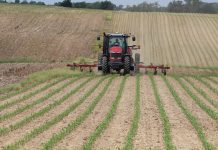The Dairy Excel 15 Measures of Dairy Farm Competitiveness bulletin was published by Ohio State University Extension to provide dairy farmers the ability to evaluate business competitiveness using financial and production information. Measure Ten, Debt to Asset Ratio, is discussed in this article (See table 1).
D/A Ratio
Solvency is a measure of the ability of a business, at a point in time, to meet all debt obligations following the sale of all assets. This is measured by the D/A ratio. The D/A ratio increases as the business incurs greater levels of debt and decreases as debt is paid off. A business with little debt has a D/A ratio close to zero.
The D/A ratio will vary through the normal life of a business. Higher ratios are common in new and expanding businesses — and often approach financially stressful levels. Debt levels may reach 60% or more during some expansions — if a lender is willing to accept that level of risk and work with the farm. High D/A ratios are acceptable for limited periods of time when plans and projections indicate that the profitable business will quickly generate funds to pay down debt and bring the ratio back to the competitive level.
A low D/A ratio is only one indicator of the financial condition of a business. When evaluating the debt position of a business, a good business manager must also look at the liquidity of the business, or its ability to meet cash obligations, and its profitability.
The D/A ratio evaluates the total debt position of the operation. It does not evaluate how the debt is structured (i.e. how much is current, intermediate or long term). The type and mix of loans, as well as interest rates, will influence profitability and cash flow.
Shorter-term loans will have higher payments compared to the same amount of dollars financed with longer repayment terms. Trying to repay debt too quickly can cause a farm to experience severe cash flow difficulties. Financing over longer repayment periods lowers the monthly payment (at the same interest rate) but causes the farm to pay more in interest charges over the life of the loan.
Typically, assets are financed for time periods reflective of their useful life. For instance, a milking parlor or robots financed using a three-year note could create cash-flow difficulties. The same milking system financed over 10 to 12 years would better fit the farm’s typical cash flows, while allowing for early payment if desired. Also look at repayment schedule and debt per cow when evaluating a farm’s debt. A business may have little debt but be unprofitable and unable to generate the cash to meet all obligations.
If that is the case, the other 14 measures may help determine why the business is not profitable.
After calculating your D/A ratio, use the table below to gauge the financial position of your farm business (see table 2).
Summary
Determining your debt to asset ratio is a straightforward process to measure the solvency of your business. If your financial position is strong, continue moving forward. If your performance is stressed/very stressed, talk to your lender, accountant, and/or extension educator to determine where and how you can improve.
Find the Dairy Excel’s 15 Measures of Dairy Farm Competitiveness at dairy.osu.edu. Additional information about farm financial management is available at farmprofitability.osu.edu/ and u.osu.edu/ohioagmanager/.














